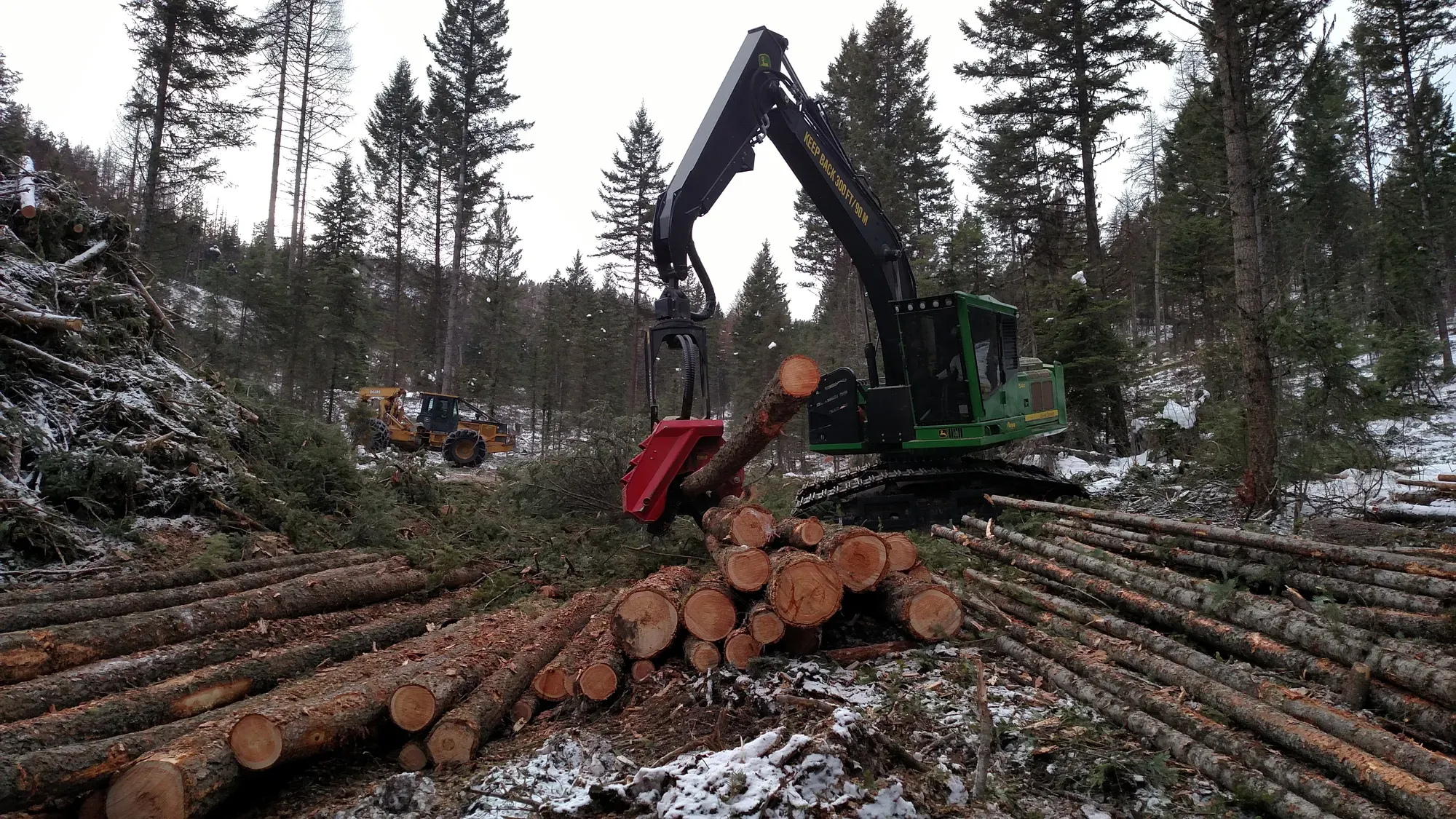The Death of the Forest Service
Utah Senator Mike Lee Wants to Kill the U.S. Forest Service We understand Senator Mike Lee’s anger over

Sharon Friedman asked a very timely question on her July 17 Smokey Wire post...
“How unique is the new Montana Share Stewardship Agreement?"
It’s unique, she reports, more focused and more transparent. It will feature a public dashboard that allows the public to stay abreast of planning and progress.
Montana’s Department of Natural Resources and Conservation [MDNRC] and the Forest Service will jointly identify landscape-scale areas where the State can implement authorized restoration goals with a 20-year mutual commitment to planning and implementation.
The 20-year commitment is probably the result of frequent cajoling by Vaagen Brothers Lumber Company owner, Duane Vaagen.
For at least a decade he has reminded Congress and the Forest Service - again and again - that millowners will not invest in new milling infrastructure related to National Forest projects without federal assurance that the designated log supply will last 20 years.
The genesis of his involvement is the Nature Conservancy’s desire to partner with him in the construction of a new high speed mill near Wenatchee, Washington. No area in Washington is at greater wildfire risk from poorly managed federal lands.
My guess – and it’s only a guess – is that he would partner with them if the Forest Service contractually offered him a 20-year log supply. It is an offer the agency has been unable to make or honor for many years.
At the moment, there are only two sawmills east of the Cascades in Washington. The Yakama Tribe’s mill at White Swan, near Toppenish, and Vaagen’s mill in Colville in the northeast corner of the state.
New mills cost north of $100 million and revolving construction loans are typically amortized over 20 years. There will be no new mills until there is log supply certainty.
Shared Stewardship is a big step in the right direction.
To our surprise, 32 states have such agreements with the Forest Service, including 22 in the West that worked through the Western Governors Association: Idaho, Montana, Oregon, Washington, California, Wyoming, Colorado, Utah, Arizona, New Mexico and North and South Dakota.
Idaho was the first state to sign an agreement. Then Governor Butch Otter and Jim Hubbard, who was then USDA Under Secretary, agreed to focus on reducing wildfire risk to communities, improved forest health and watershed conditions and support for markets to sustain and create jobs in the forest products sector. Their stated goal was to double the number of National Forest acres treated by focusing on 6.1 million acres of private and public lands impacted by insect and disease infestations.
Idaho and Montana both completed their collaboratively developed Forest Action Plans in 2020.
Both plans rely on similar principles, both have advisory committees and both emphasize the use of thinning, stand tending and prescribed burning to reduce wildfire risks to communities, forests, recreation assets and fish, wildlife and plant habitat.
The Montana Shared Stewardship Agreement that Friedman dug into identifies the first of four projects, a 200,000-acre, 20-year project that spans parts of the Kootenai and Flathead National forests. The project, scheduled to begin in Fiscal 2026, and will use Good Neighbor Authority [GNA], which was included in the 2014 Farm Bill, to lay out a project that focuses on marketable timber that meets the requirements of President Trump’s Executive Order 14225.
EO 14225, was signed by Trump on March 1, 2025.
It notes that “the production of timber, lumber, paper, bioenergy and other wood products [timber production] is critical to our Nation’s well-being.”
Apart from Trump, I can only name two other U.S. Presidents who have spoken as forcefully about the need to help this nation pull itself up by the bootstraps. Both were Democrats.
· Franklin Roosevelt with his New Deal, which began in 1933 with a series of social and economic programs designed to lift the country out of the Great Depression.
· Harry Truman with his push to open the West’s largely unroaded National Forests following World War II. It unleashed a home construction boom unlike anything the nation had ever seen, spurring a period of unprecedent economic prosperity.
In three short paragraphs within EO 14225, Trump nails it like no one since FDR and Truman.
· The United States has an abundance of timber resources that are more than adequate to meet our domestic timber production needs, but heavy handed Federal policies have prevented full utilization of these resources and made us reliant on foreign producers.
· “Our inability to fully exploit our domestic timber supply has impeded the creation of jobs and prosperity, contributed to wildfire disasters, degraded fish and wildlife habitats, increased the cost of construction and energy, and threatened our economic security.
· These onerous Federal policies have forced our Nation to rely upon imported lumber, thus exporting jobs and prosperity and compromising our self-reliance. It is vital that we reverse these policies and increase domestic production to protect our national and economic security.
What Trump describes is music to the ears of rural westerners who have lived with “heavy handed Federal policies” that have raised holy hell with their economic and community security since the Northern Spotted Owl was listed as a threatened species in 1990. Worse, the listing was based on a phony science narrative assembled by a small group of scientists who worked behind locked and guarded doors in Portland, Oregon’s aptly named “Tower of Power.”
Of course, Trump didn’t actually write EO 14225 – which sounds like something we could have written for him – but he gets the credit and criticism for the Order, just as other Presidents have during and following their White House years.
Blessedly, our colleague, Chad Oliver, possibly the world’s leading authority on forest stand dynamics, has said that, if asked, he would be pleased to review the updated Northwest Forest Plan.
It’s main tenant is a controversial U.S. Fish & Wildlife Service plan to shoot 450,000 barred owls over the next 30 years – 15,000 per year!

Why?
Because the federal agency says that barred owls are preying on spotted owls and interbreeding - and threaten an already endangered population.
Over 25 years after the spotted owl decision and the population is still in freefall.
Now, the public is being asked to accept that "accountability/a solution" comes byway of a decision that sets up a false equivalency - targeting only one variable as the cause. No equally drastic action is suggested for the other variables that were ignored, not accounted for, or concealed.
Millions of acres of owl habitat have been incinerated in wildfires since the 1990 listing - fires that would have been far smaller and less destructive had the Forest Service been allowed to do the thinning and stand work necessary to reduce risks. Severe mega fire's contribution to the decline of the spotted owl population is not highlighted in the USFW's report.
Enter the serial litigators...
Trump’s direct references to domestic timber production and heavy handed federal regulation reveals his understanding of the nation’s housing crisis - and his belief it should be solved with timber from U.S. forests, not imported wood.
Wall Street Journal columnist, William Galston, reports that the median age first time homebuyer in the U.S. is now 38 years old. “That’s bad for America,” he wrote on July 16.
Separately, Turning Point columnist, Charlie Kirk, recently told the Washington Post that he believes the Trump Administration must “improve the material conditions of the younger voters” by building 10 million homes – a Marshall Plan-type thing.”
The President’s actions suggest he shares Kirk’s belief.
Trump’s EO 14225 reverses course by ordering new and updated guidance from the Secretaries of Ag and Interior based on further use of GNA and other forestry tools that can increase timber production and sound forest management, reduce time to deliver timber and decrease timber supply uncertainty.

Also cited, “Agreements or contracts with Indian tribes under the Tribal Forest Protection Act.” The Act, ratified by Congress in 2004 as a companion to the Healthy Forests Restoration Act, gave tribes the authority to treat wildfire risks and associated insects and diseases in dying federal forests adjacent to their well-managed forests.
Alaska U.S. Senator, Lisa Murkowski, is adding an amendment to the 2004 Act this year to include 44 million acres of Alaska Native Claims Settlement lands awarded to tribes in 1971 in an Act signed by President Nixon.
Contrary to a widely held belief, tribes are not exempt from federal environmental regulations, including the National Environmental Policy Act [NEPA] and the Endangered Species Act [ESA].
Tribes meet or exceed all federal environmental laws and regulations. But litigation ultimately paid for by taxpayers under Equal Access to Justice Act [EAJA] has made it impossible for federal resource management agencies to meet their own government’s standards. Trump aims to fix this too.
Justice Department lawyers are doing a better job of defending the Forest Service in federal court, but Congress still needs to put sideboards on EAJA. Litigators and the environmental groups they represent intentionally weaponized the Act in a way lawmakers never intended.
This madness will continue until Congress finds a way to limit the Act’s use or scraps it in favor of binding arbitration, the better choice in our opinion.

You 100% tax-deductible subscription allows us to continue providing science-based forestry information with the goal of ensuring healthy forests forever.